Battle for Zendikar and the This Always Happens Theory
Many people (myself included) have argued that Battle for Zendikar has been a weak set comparatively. Some people attribute this to Wizards powering down Standard, which they do every so often to reign in power creep. Supporting this argument is the fact that relatively few non-land cards from Battle for Zendikar were featured in the Top Eight of Pro Tour Battle for Zendikar. When I point this out, one of the typical responses is "this happens every time — cards from the newest set rarely see heavy play right off the bat."
On one hand, this argument is true. It is unreasonable to expect a single set to overwhelm an entire block (and a core set) of established cards, synergies, and archetypes. By the numbers, Battle for Zendikar is only one-fifth of Standard (slightly more if you consider set size). Given that Battle for Zendikar starts behind other sets, even reaching a 20% threshold of "played cards" is unlikely two weeks after the set released.
However, even with this in mind, I think the numbers paint a pretty clear picture of Battle for Zendikar: it's an underwhelming constructed set. For today, let's use some Pro Tour history to see how Battle for Zendikar stacks up to other sets.
Important Stuff
How many cards from the newest set see play at the Pro Tour immediately following their release? To answer this question we will use only the fall (October) Pro Tour. It wouldn't be fair to compare a post-rotation to a non-rotation Pro Tour. While this comparison isn't the best metric, for the sake of simplicity we are going to use the Top Eight decks from each tournament as our sample size. All in all, there are 600 cards in a constructed Top Eight (eight 75 card decks). However, we are not going to include lands in our sample for a couple reasons. First, the number of basics that are played can skew the numbers. Second, and most importantly, the Rare land cycle from the fall set always sees play no matter how good or bad it may be. The land cycle may not be the greatest of all time, but it will be the best (or second best) in Standard and the foundation for most tournament decks.
Incidentally, including lands wouldn't have helped Battle for Zendikar. Thanks to the interaction of slowlands with fetchlands, many decks are only playing one (or two) of each slowland. By including lands in our analysis, we undervalue Battle for Zendikar even more, which is the last thing the set needs.
We are also going to exclude sideboard cards because they are more a function of the metagame than a statement of a card's power. Very few people would argue Arashin Cleric is a great card, but it manages to be the most played sideboard card in our current format.
Pro Tour Khans of Tarkir
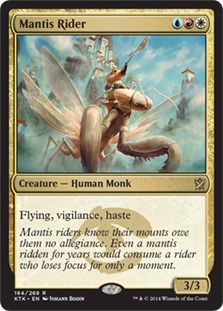
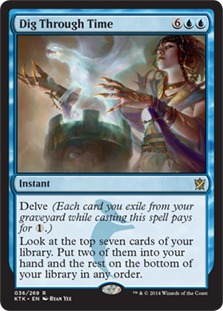

There were 275 main deck, non-land cards in the Top Eight of Pro Tour Khans of Tarkir. Of these cards, 121 were from Khans of Tarkir. In other words, a full 44% of non-lands card at the Pro Tour were from the namesake set. This number far exceeds the 20% we would have expected if all sets were equally represented. In fact, Khans of Tarkir was the most represented set in that Top Eight.
Even more impressive, there were 19 different Khans of Tarkir cards in the Top Eight of Pro Tour Khans of Tarkir. So while Dig Through Time and Mantis Rider were heavily represented, they were far from the only Khans cards to make an immediately impact on Standard.

Pro Tour Theros

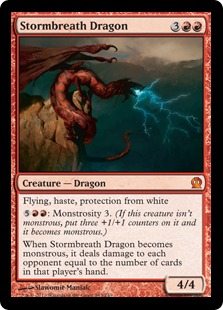

Here it's important to remember Theros was widely panned for being underpowered when the set was released, much like Battle for Zendikar. People even used the same argument: Wizards was "powering down" Standard after the powerful Return to Ravnica block. However, Theros' numbers at the Pro Tour were still impressive. At Pro Tour Theros there were 281 non-land, main deck cards in the Top Eight. Of these, 113 (39.6%) came from Theros.
In addition, the Theros cards at Pro Tour Theros were even more diverse than Khans in its respective Pro Tour. There were an amazing 23 different Theros card in the Top Eight. In other words, nearly a quarter of all Theros Rares and Mythics were in the Top Eight of Pro Tour Theros.

Pro Tour Battle for Zendikar
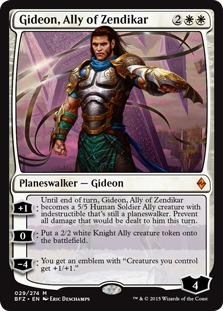
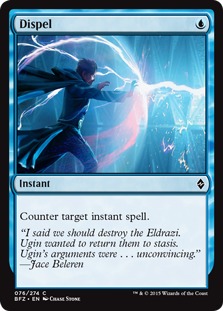
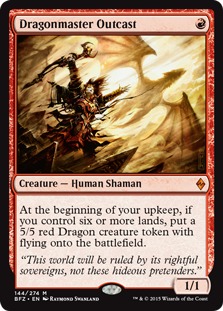
Exactly the same as Pro Tour Theros, there were 281 non-land, main deck cards in the Top Eight of Pro Tour Battle for Zendikar. Care to wager how many of these card were from Battle for Zendikar? A grand total of 26. That's right, only 9.25% of the non-land cards in the Top Eight at Pro Tour Battle for Zendikar were from Battle for Zendikar. More shockingly, there were only three different Battle for Zendikar cards represented. Two of these were reprints!
At Pro Tour Battle for Zendikar there were 20 Gideon, Ally of Zendikar, 4 Dispel and 2 Dragonmaster Outcasts in the Top Eight. Not only was Battle for Zendikar massively underrepresented at the tournament, it had less diversity than previous sets.

Putting It All Together
Logically, if "this always happens" to new sets, the percentage of cards from the new set should be roughly even. Sure, some sets will be less than others because of power-level differences, but it should be somewhat close. Let's see how these three sets stack up side by side. First, here's the percentage of cards from the newest set to make the Top Eight of the Pro Tour:

Next, let's see the number of unique cards from each set to Top Eight:

This data provides irrefutable evidence that no, this isn't what always happens. At least for recent sets, Battle for Zendikar was epically underplayed at its namesake Pro Tour. I would have gone back further, but I ran into a few problems. First, Pro Tour Return to Ravnica and Pro Tour Innistrad were Modern. Second, before Return to Ravnica, Pro Tours were not aligned with set releases. I considered using Tops Eights from SCG events or Grand Prix, but this is a poor comparison. For a Pro Tour, all the best players in the world spend weeks trying to break the format. This level of preparation isn't the case for Grand Prix-level events and definitely not for SCG Opens.
This said, I did examine the two biggest Grand Prix (GP) in the month following the release of Return to Ravnica and Innistrad. At GP Bochum in October 2012, just weeks after the release of Return to Ravnica, 65 of the the 293 non-land cards in the Top Eight were from Return to Ravnica. At 22.18%, this puts Return to Ravinca at nearly half of Theros or Khans of Tarkir. Yet, it's more than double the rate of Battle for Zendikar. At GP Hiroshima in October 2011, weeks after Innistrad's release, 78 of the 298 non-land cards in the Top Eight were from Innistrad. That's 26.17%, still poor compared to Theros or Khans, but almost triple that of Battle for Zendikar.
Now here's where I say something hyperbolic like Battle for Zendikar is the worst constructed set of the mythic era, but we simply don't have enough information to make such a brash claim. However, I can say with confidence that Battle for Zendikar is the least impactful fall set for constructed in the past half decade. It isn't particularly close. Battle for Zendikar is played at less than half the rate of the next worst set (Return to Ravnica) and one-fifth the rate as the most played set (Khans of Tarkir).
Why is BFZ so Lacking in Impact?
1. Powering Down
Now just because the numbers show the "this always happens" argument is clearly bunk, it does not make the idea of Wizards trying to power down Standard wrong. Quite the opposite in fact. The problem with making each set more powerful than the last is that power creep reaches extreme levels. To combat power creep, the power level of sets is handled in a cyclical manner. While I don't have any real data to back this up, going by my subjective perception of set power level, you can get an idea of how this process works.

Over time, Magic set design takes on a peaks-and-valleys pattern. As players we want every set to feel powerful, full of cards for Standard and a few for eternal formats. However, if Wizards starts trying to make each set "better" (i.e. more powerful) than the last, we end up in a dangerous place. 75's become 90's. 90's become 110's. Pretty soon cards that were considered powerful a few years back look horrible compared to the new hotness. Remember, if Khans of Tarkir is a 75 in power level, topping that means cards more powerful than Siege Rhino, Dig Through Time, Mantis Rider, and Treasure Cruise. While as players we might think this is what we want, if look at things objectively, it's really not what we want. The game would Time Spiral out of control. In fact, one of the most impressive things Wizards has done with Magic is keep cards from 1993, 2003, and 2013 relevant. Pulling off this feat means set power level cannot just go up, up, up — sometimes a reset is needed.
I don't question the need to "power down" Standard from time to time. It's good for the game in the long run. However, I do question two things about powering down Battle for Zendikar. First, if you look back on the "subjective power level" chart, you'll see that the fall set has always been the most powerful set in a block. As such, I think Wizards has unintentionally created an expectation that the fall set will be powerful. If a winter or spring set doesn't have a huge impact on Standard, we aren't really surprised. We've lived through Dragon's Maze and Fate Reforged. But when the large fall set doesn't make a dent in Standard, we take notice.
Second, at a meta-level, I question powering down a much hyped "return to" set. We just talked about how players have an expectations that the fall set will be powerful. Well, "return to" sets double that expectation. When you heard we were returning to Zendikar, what did you think of? What do you remember from the old block? For me it's fetchlands, but also, in no particular order, creature-lands, Goblin Guide, Emrakul, the Aeons Torn, the best limited format of all time (triple Rise of the Eldrazi), powerful landfall cards, and Jace, the Mind Sculptor. The past colors the present. While we may not realize or admit it, we expect Battle for Zendikar will be a worthy successor to the original Zendikar. When it ends up being the least impactful fall set in half a decade, we end up disappointed.
Optimistically, my guess is that this has something to do with the new, two-set-block cadence. Wizards has been upfront about wanting to eliminate the third set problem. Traditionally, third sets have been weakest in a block. Now we don't have third sets to worry about anymore. It's possible that instead of a constant powering up and powering down process, the new smaller block Standard will have more consistent power levels. Maybe instead of ranging from 15 to 80, most sets will fall between 40 and 60. It's also possible Wizards wanted to start off the new system with a low power level so that they could blow our hair back with sets that are due next year. Maybe Wizards is intentionally sending a message that "it's not all about the large fall set anymore," and we should expect any of the four sets released each year to be potentially powerful. While I'm not totally sure of the reason, I'd be willing to bet that the new block cadence plays a role in the underpoweredness of Battle for Zendikar.
2. It's Parasitic
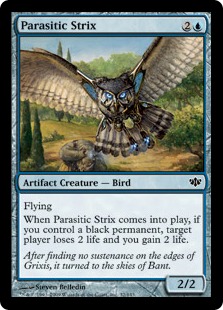


If you're unfamiliar with the term "parasitic" in regards to Magic design, here's a brief description Mark Rosewater gave in his Design 103 article,
Cards that are too parasitic say, "No, just look at this tiny subset of cards."
The ingest mechanic asks you to care about cards in the exile zone, a zone that has been off limits to Magic design for most of the game's history. Until Battle for Zendikar, the exile zone has been the super graveyard, a place of no return. You can't reanimate cards from exile and you can only return cards from exile to your hand in very rare and specific circumstances. If you look at the other four sets in Standard, there is literally nothing that works with ingest. For the mechanic to work in Standard, it needs enough support from Battle for Zendikar alone. Obviously, that didn't happen.
How about devoid? Sure, there are some fringe case where it matters (equipping a Ghostfire Blade to Sludge Crawler), but Wizards recently removed "colors mattering" (and therefore colorlessness mattering) when they announced protection would no longer be used regularly. How can you make devoid cards matter? By amping up protection instead of taking it away. In Standard, Kor Firewalker would make Touch of the Void playable. Being able to Completely Disregard a Mirran Crusader would be awesome. With protection gone, this tension is missing.
The rally ability on Allies makes me think Wizards realized the parasitic nature of the set was a problem. The old Allies were extremely parasitic. Rally, on the other hand, expands the definition of Allies. While Allies still like being played with other Allies, they don't depend exclusively on their friends to perform since they grant a bonus to all of your creatures, rather than just Allies.
If you look at the mechanics from other large fall sets, it was their synergy with other sets in Standard that helped them see play. Gray Merchant of Asphodel and Master of Waves were immediately playable because they synergized well with Return to Ravinca block cards like Nightveil Specter and Underworld Connections. Or take for example Khans of Tarkir. Raid cares about attacking (happens every game), Delve cards about the graveyard (where cards go when they die), Prowess just cares about spells, Ferocious only cares about powerful creatures, and Outlast only cares about +1/+1 counters.
Now imagine if raid said "you get this ability, but only if you attack with a creature from Khans of Tarkir". That's how many of the mechanics from Battle for Zendikar work.
3. It is Missing Obviously Powerful Cards
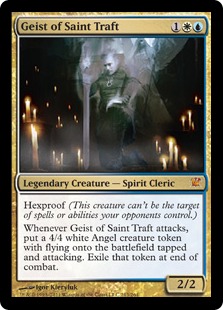


If you look at the cards from the fall sets that debut at the Pro Tour, most are powerful on their face. Mantis Rider, Butcher of the Horde, and Dig Through Time are powerful effects. Geist of Saint Traft, Snapcaster Mage, and Liliana of the Veil look great on paper. Abrupt Decay and Supreme Verdict are very good at what they do. Even sets of low power level have a few cards that are "best in class" in various categories in Standard. Theros (a "power down" fall set) had Thoughtseize, the best discard spell in Standard. Dragon's Maze had Voice of Resurgence.
In Battle for Zendikar, there is exactly one non-land card that jumps off the page as being so powerful you just have to put it in your deck: Gideon, Ally of Zendikar. There are very few cards you can argue are "best in class" for the current format. Planar Outburst? Not clearly better than Languish or End Hostilities. Undergrowth Champion? Likely worse than Den Protector or Deathmist Raptor. Is Ruinous Path the best removal spell in the format? Maybe, but not for sure. Omnath, Locus of Rage is cute, but it just doesn't match up to Dragonlord Atarka if you're looking for a Green-Red seven-drop. I could go on, but if you look at the cards typically played in Standard, Battle of Zendikar cards aren't the best.
The areas where Battle for Zendikar clearly has the best cards in Standard aren't important slots. This list includes things like best five-mana planeswalker - Ob Nixilis Reignited, best ten-mana creature - Ulamog, the Ceaseless Hunger, and best Red one-drop for a non-aggro deck - Dragonmaster Outcast. While these cards are technically best in class, you can't expect them to see heavy play. It is like being the best kazoo player in the world. Sure, it's great that you're the best at something, but you're the best at something very few people care about.
Now I know what you're thinking. "Wait a minute Seth, you just told us it's dangerous for Wizards to continually ramp up power level, and now you're arguing Battle for Zendikar isn't powerful enough. What gives?" Here's the thing. For Battle for Zendikar to make an impact on Standard, it doesn't need to top cards like Siege Rhino, Dig Through Time, and Mantis Rider. In fact, you can build a powered down set and still have that set leave a mark in Standard. Here's how.
- Have two or three cards that are clearly the best at what they do and make sure they fit in commonly played slots in Standard. Battle for Zendikar has one in Gideon, Ally of Zendikar. Having a couple more wouldn't hurt. Make sure a handful of Rares and Mythics are powerful enough to see immediate play in Standard. Admittedly, this will raise power levels a bit, but if you only increase the power on a very small number of cards (and you rotate these slots), power creep shouldn't be an issue.
- Pick and choose your spots and take advantage of lower rarities. For example, throwing a Bloodthrone Vampire at Common doesn't increase the power level of the set at all, but the card would immediately see play in Aristocrat builds and make the set appear more powerful. Or what about outclassing Silkwrap with Journey to Nowhere? Or Ultimate Price with a 1B Uncommon that says "destroy target colored creature" to play up the devoid theme of the Eldrazi. The point is, you can make sure cards show up at tournaments by making them the best at what they do, but also making what they do very narrow (Dispel in Standard or Pyroblast in Legacy).
I guess what I'm trying to say is that having cards from Battle for Zendikar make up less than 10% of the field at Pro Tour Battle for Zendikar is embarrassing. While I agree with the need to power down Standard from time to time, I think there are ways to power down Standard without making people like me write about how weak the set truly is. The numbers can be shifted to the "normal" 20% play rate with only a handful of changes that don't risk endless power creep. It's just a matter of taking advantage of them.
Conclusion
Anyway, that's all for today. As always, leave your thoughts, opinions, and idea in the comments. You can reach me on Twitter (or MTGO) @SaffronOlive.













